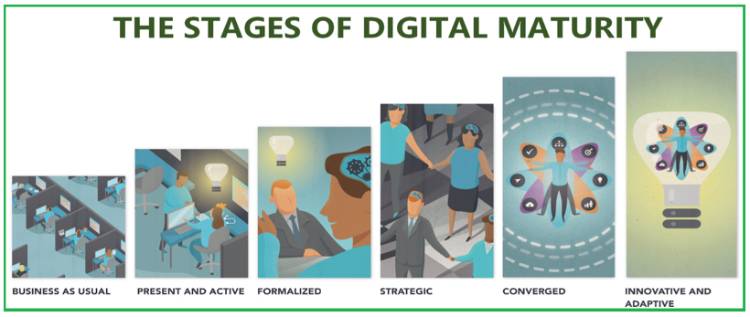 Faheem Ali, expert in financial Inclusion and digital transformation.
Faheem Ali, expert in financial Inclusion and digital transformation.
Digital transformation is a leading force in business today. Experts say that in the wake of COVID-19, there is an urgent need for many enterprises to digitalize and tap into enormous opportunities. Whether it's based upon employing a shrewd offense or cautious defense, this change will impact all companies.
But what is digital really? Who should own it within the enterprise? What processes and technologies are necessary to bring it to life?
Digital transformation may seem like a new buzzword for an old topic.
The digital revolution
It is necessary to digitise your culture. This requires hiring for and encouraging learning agility among your employees. New technologies and techniques emerge much faster than in the past. The technology that one is comfortable with today may be obsolete tomorrow. Will your employees be willing to retrain on the more modern technologies and techniques?
Use modern solutions, such as Cloud and mobile-enabled technology rather than mainframe technology of the past. But not taking these first steps can mean that you'll be a victim of your own success, unable to reap the rewards that higher demand might bring.
Develop or hone an edge-based innovation function. This entails developing or recasting an existing research and development arm. Seeking new business opportunities that exploit digital technologies at the edge of current product or service offerings, or perhaps in adjacent spaces to the current offerings.
The rest of the business should think further about how digital opportunities can transform the core business. An eye toward better customer experience through digital channels should be paramount, as customers expect easier, intuitive, and compelling digital experiences when they become more sophisticated. The digital revolution that's upon us is an enormous threat to a lot of businesses, but it also can be a tremendous opportunity for those who leverage the new ways of operating.
Remember, digital transformation is the coordinated digitalization change efforts at scale, diffused through the operating model and all aspects of the business, including people, processes, technologies, and metrics. The goal of this is to bring meaningful outcomes to the organization.

The stages of digital maturity - a new mindset
Does your company is able to interact with customers online through your company website or Customer Relationship Management (CRM)? Do you have an active social media presence? Do you offer your products and services digitally? How advanced or mature is your digital offering?
Dealing with specific problems or projects at a functional level – business, human resources or marketing, for example - can deliver improvements. However, functional transformation is often done in a disconnected manner without thinking about linkages across the organization. Lack of coordination results in redundant expenditures, data fragmentation, and leaves the anticipated value of digital investments under realised.
It takes time, energy, and vision to look at ecosystems across the enterprise, but it is that broader perspective that offers large, lasting improvements.
Businesses adopting an end-to-end ‘connected venture’ mindset that centers around the customer value proposition will be the ones that outperform and thrive as we head towards the new reality. In essence, every change in technology and process should be customer-centric in spirit and impact so that data and insights flow freely, driving informed decision-making and fostering new levels of collaboration. Greater levels of maturity are likely to translate to greater levels of value.
Who should lead the digital agenda?
At a recent gathering of World Innovation Series 2020 of CIOs, CISOs, BFSIs and other executives, I asked the audience, how many of their companies had a Chief Digital Officer (CDO)? Amazingly, only about five raised their hands. Through an instant poll, I was able to determine that a little more than 50 per cent of the Chief Information Officers either owned the digital agenda or co-led that agenda. This may seem surprising, but let's dig into how companies should think about the person who leads the function.
Many CEOs and leadership teams of companies think of the true digital opportunity as one that is revenue-centric. But what about the operational aspects that are necessary to make that happen? In order to advance digital capabilities it requires organization and change management, which is the model and management practices in place to facilitate the speed and flexibility required in digital growth and development.
Functional processes that drive and support day-to-day operations of the business and the generation of revenue. Architecture and tools which includes the governance infrastructure and applications responsible for the collection and maintenance of data used in digital initiatives. Leaders of customer-centric functions may not have experience or expertise in the areas necessary to influence each of these. Likewise, there are many technical changes necessary in order to transform a company to be digital ready.
Employee Skills Needed for Digital Transformation
There are several skills that become more important for digital transformation. First, it's necessary to hire skills associated with Agile development. Digital transformation requires Agile development which focuses on developing projects iteratively. This is in contrast to the traditional waterfall method which is serial in nature with handoffs along the way. Agile coaches are key new roles in this paradigm. They're part change manager, consultant and trainer.
The second skill necessary related to Agile development is the scrum master.
The third skill necessary to incorporate into your teams is the product owner. In the digital age, to a greater degree, one must think of traditional projects or services of the company as products.
The fourth skill that's required for digital transformation is the user experience- UX designer. UX encompasses both customer experience and employee experience depending on who a given product or project is directed toward.
When businesses are forced to change because of a pandemic, the advantage is that they can intensify their services through digitization, and digital transformations. As the result, they can solve problems in sales, operations, and logistics channels. There are four things that can be implemented for digital transformation: ensuring business to remain competitive, bringing efficiency in business processes, increasing customer satisfaction and making it easier for business people to make various strategic decisions.
Next Steps
In the same way that a heart attack can serve as a wakeup call and impetus for lifestyle changes for those suffering from chronic heart disease, the COVID-19 crisis and other acute disruptions can serve as an opportunity for organizations to make some fundamental shifts and to implement structures and practices that will enable them to thrive.
The road to new reality will have many twists and turns, and perhaps even a few potholes. However, organizations which accelerate their digital transformation, will continue to win over their customers.
The writer, Faheem Ali is an expert in financial Inclusion and digital transformation.




No comments :
Post a Comment